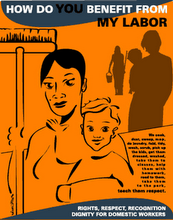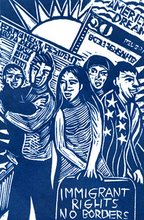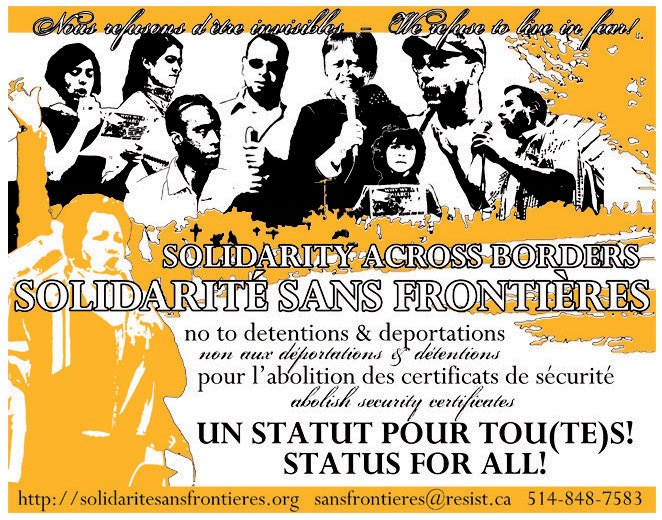Globe and Mail - 31 Jan. 2007
Immigrants battle chronic low income
Some newcomers' fortunes haven't risen in line with skills, 15-year study finds
MARINA JIMÉNEZ
A landmark national study confirms what new immigrants already know: They are financially no better off now than they were at the turn of the millennium, and have poverty rates three times higher than Canadians, despite their high levels of education. The Statistics Canada study is an
indictment of Canada 's immigrant selection model, which actively recruits skilled professionals, most of whom cannot get work in their fields, and are forced to accept jobs delivering pizza or pumping gas.
In 2002, low-income rates among immigrant families during their first full year in Canada were 3.5 times higher than those of people born in Canada -- higher than at any time in the 1990s. By 2004, they were 3.2 times higher. This is the first-ever study examining the chronic low income of immigrants, and the researchers tracked as many as 280,000 people over 15 years.
The study, released yesterday, found that the probability of entering a low-income period was very high for immigrants during their first year in Canada , ranging from 34 per cent to 46 per cent. If immigrants did not accept a low-wage job during their first year, the likelihood of entering a period of low income fell to 10 per cent or less, suggesting that they are better off holding out for a job in their field, rather than accepting a minimum-wage job. "The shift to more educated and skilled-class immigrants has changed the face of the chronically poor in the 1990s," wrote Statscan analysts Garnett Picot, Feng Hou and Simon Coulombe.
Low income was defined as $26,800 for a family of four; immigrants who fell in that category for at least four of their five years in Canada were considered to be chronic low income. The study found that one in nearly five immigrants who arrived between 1992 and 2000 were living in a state
of chronic low income.
"The study validates what we intuitively know: There is a huge disconnect between the labour market and our immigration program," said Ratna Omidvar, executive director of the Maytree Foundation, which promotes the integration of immigrants. In 1993, Ottawa modified the selection model for immigrants to attract more highly educated newcomers. The proportion of new immigrants with university degrees rose to 45 per cent in 2004 from 17 per cent in 1992.
These highly educated immigrants might have been expected to earn more. However, by the early 2000s, skilled immigrants had a greater chance of being low income than immigrants who came in under the family reunification program. The downturn in the high-tech sector in 2000 also
had an impact, the report notes. "I was certainly misled," said Denis Mathew, a 32-year-old MBA graduate from India who came to Toronto in October, 2006.
"The advertisements for Canada overseas gave the impression that there is a lot of growth here. "But the only opportunities here are for unskilled labour." Mr. Mathew has more than 10 years experience in advertising in India and Dubai and worked for the eighth-largest advertising firm in the world, Hakuhodo Percept.
However, his expertise counts for nothing. Mr. Mathew has been to more than a dozen interviews, and is always told the same thing: "You must have Canadian experience," he said with a rueful laugh. It is a vicious circle. He cannot get the Canadian experience unless a Canadian employer will take a chance on a newcomer.
The Conference Board of Canada estimates that the un- and underemployment of immigrants costs the economy as much as $5-billion a year, said Harish Jain, professor emeritus at McMaster University 's DeGroote School of Business. "It is not just the cost to the economy, but the demoralizing effect on immigrants, which can result in social upheaval," he said. The government has launched a number of initiatives to assist newcomers, including a federal agency to help foreign professionals integrate into the work force. Ontario passed a bill last year to help ensure that regulatory bodies that license professions are more transparent.
But many immigrants are in non-regulated professions, including finance, business, information technology and human resources. "It's the failure of the community of people who hire," Ms. Omidvar said. Some corporations are taking small steps to open their doors to skilled foreigners. The Royal Bank of Canada , for example, has stopped asking applicants where their degrees are from in an attempt not to screen out immigrants.
Without more measures such as these, more and more skilled professionals such as Mr. Mathew will give up on Canada . A 2006 Statistics Canada study found that one-third of male immigrants leave within 20 years of their arrival -- more than half within their first year of arrival. "It is a
criminal waste of my knowledge and experience," said Mr. Mathew, who plans to leave Canada by the summer if he doesn't land a job in his field.
skip to main |
skip to sidebar

















Blog Archive
-
▼
2007
(540)
-
▼
February
(124)
- Raymondville: Inside the Largest Immigration Priso...
- Human Rights Groups Call for Closure of Texas Jail...
- "I Want To Be Free": 9-Year-Old Canadian Citizen P...
- Canadian Council for RefugeesMedia ReleaseFor Im...
- Detention solution found wanting in Britain
- Foreign Workers Can Stay Longer in Canada, Tories Say
- More Mexican labour needed in oil patch, executive...
- Canada's hottest new import? Employees
- The Battle Over Immigration - U$A
- Families Behind Bars: Jailing Children of Immigrants
- Which Babies Are Real Americans?
- Court strikes down security certificates
- Top court rules against security certificates
- UN Grills Canada
- US War Resisters and the Legality of the Iraq War
- Report on the State of Racism in Canada
- UN wants guarantee that Canada won't repeat Arar e...
- Groups condemn immigration raids
- Appeals sought for refugees on run
- Amir Kazemian Accepted
- Canada turns crucial corner
- Charkaoui hails high court ruling
- Nafta Should Have Stopped Illegal Immigration, Right?
- Border Crackdown Spawns Violence. More Deaths Occu...
- Apatrides et menacés de déportation: Relance des p...
- Stateless & Deported: Re-launch of bi-weekly picke...
- Show Anti-Raciste dans Hochelaga
- La Cour suprême va se prononcer sur les certificat...
- Community Sanctuary: Celebrating Struggles for Jus...
- Sanctuaire Communautaire: Une célebration des lutt...
- Radio-Canada: Amir Kazemian est libre
- PC: Un réfugié iranien vivant dans une église est ...
- Winnipeg Free Press: Refugee family's children all...
- Globe and Mail: Iranian refugee granted asylum
- Emprisonnement de présumé terroriste
- Latvian national in St. John's church loses immigr...
- Iranian Refugee Arrested and Forced out of Sanctua...
- Protest groups seek abolition of controversial sec...
- Canadian boy caught in Texas detention
- La Cour ordonne la libération de Mahjoub, à la vei...
- Mohammad Mahjoub, le plus ancien détenu en vertu d...
- Mahjoub ordered freed pending government review of...
- Mohammad Mahjoub, Longest Held of Canada's Secret ...
- Terrorism suspect given hope by MPs' offer of aid
- Deportation Cases Not Properly Reviewed
- Gunmen Open Fire on Illegal Immigrants
- Kenyan-born man has credentials to be registered p...
- MPs meet with detainees on hunger strike
- (((( We send this article with the note that these...
- GUANTANAMO NORTH - DAY 80 OF HUNGER STRIKE
- Draconian' anti-terror laws must go
- National Union urges opposition to Anti-Terrorism Act
- The Don't Ask Don't Tell campaign is working on ma...
- Proceedings on hunger strike, Standing Committee o...
- Syria bars Iraqis refugees, crisis worsens
- US Doesn't Sign Ban on Disappearances
- U.S. May Be Mishandling Asylum Seekers, Panel Says
- Refugee agreement hurts queers
- UPDATE ON HUNGER STRIKES AT GUANTANAMO NORTH
- Refugee case tests safe-haven law
- Can't prove he's gay, teen is denied asylum
- Court acquits immigration consultant
- Canada, U.S. pact on refugees flawed, lawyer says
- Retour du balancier à Hérouxville
- Acommodements raisonnables
- Town stands by its norms
- Police officer faces discipline for penning song a...
- Muslim groups to launch complaint over town's immi...
- Immigrant debate has 'gone too far': Charest
- U.S. no safe haven for refugees, court told
- Passport applicants find they're not Canadian
- Guyana nationals still being held in N.B.
- 3 charged with human smuggling released
- Canaries migrant death toll soars
- Mauritania food aid for migrants
- Destination UK
- UK border plans unveiled
- Everyday Police Intimidation Caught on Film
- Position de la TCRI relatif au débat actuel sur le...
- Des grands-parents palestiniens menacés d’expulsion
- Déclaration en réponse au débat sur les « accomode...
- No One Is Illegal-Montreal statement on the racist...
- YMCA, fête du Solstice, Hérouxville...
- Immigrants battle chronic low income
- Up to Democrats to investigate Torture
- Hunger strikers being 'left to die' by 'unaccounta...
- Speak up, Mr. Harper – Guantanamo is a disgrace
- How does multiculturalism translate for minorities?
- Iranian refugee wins first battle in bid to teach ...
- How Canadian are you?
- 9/11's echoes and mixed bliss
- UN seeks haven for Iraqi refugees
- Canadians admit racist tendencies
- Immigrant teachers struggle to find work
- Activists descend on CBSA offices to protest Canad...
- One official's 'refugee' is another's 'terrorist'
- Need realistic policies on racism: Kenney
- Cdns wants tighter immigration controls
- Immigrants Mistreated, Report Says
- Protesters push for action on immigration issues
-
▼
February
(124)


Qui sommes nous:
Solidarité sans frontières est un réseau basé à Montréal qui lutte en faveur de la justice et de la dignité pour tou-te-s les sans-statut. Nous sommes un regroupement de migrant-e-s, d'immigrant-e-s, réfugié-e-s et leurs allié-e-s. Nous mobilisons pour toutes ceux et celles qui se battent contre la déportation, la détention et les certificats de sécurité.
About us:
Solidarity Across Borders is a Montreal-based network of migrants, immigrants, refugees, and allies engaged in the struggle for justice and dignity for migrants and refugees. We mobilize for all who are caught in the immigration regime and for all who fight against deportations, detentions, and security certificates.


Labels:
- War on Terrorism/Guerre contre le terrorisme (81)
- Fortress North America (64)
- Secret Trials/Proces Secret (58)
- Exploitation: Immigrant Workers/Travailleurs-EUSES immigrantEs (45)
- Migrant Resistance (37)
- Sanctuaire/Sanctuary (35)
- Detention (31)
- "Reasonable" Accomodation (30)
- Deportation (29)
- Fortress Europe (26)
- Racism (22)
- Indigenous Resistance (15)
- Propaganda (14)
- Police Harrasment/Harcelement policiere (10)
- Racial Profiling/Profilage Racial (10)
- Guantanamo (6)
- Anti-racism/Contre le racisme (4)
- Palestian Refugees/RéfugiéEs PalestinienNEs (4)
- Solidarity Across Borders (4)
- Solidarité sans frontières (4)
- Don't Ask Don't Tell (3)
- unionization/syndicalisation (3)
- Guantanamo North (2)
- LGBTQ (2)
- Labour (2)
- People's Commission (2)
- Police State/Etat policier (2)
- White Supremacy (2)
- Women (2)
- Raids (1)


Info:
(514) 848-7583
sansfrontieres[at]resist.ca
www.solidarityacrossborders.org

Contributors


Links:




